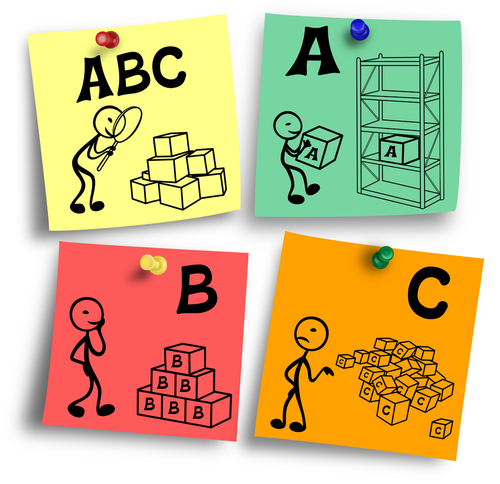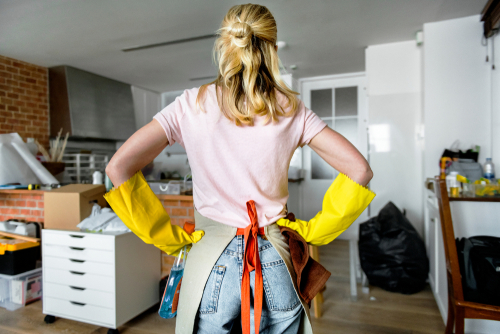April 25, 2024 - Benjamin Ehinger
How to Purge Your House: Getting Rid of the Clutter
CALL NOW 844-762-8449
Embarking on a mission to purge your house can be a transformative endeavor, not just for the space you live in but also for your mental well-being and peace of mind. Removing clutter and excess items from your home is about creating a serene environment where you can relax and be productive. When you decide to tackle the clutter, consider securing a residential dumpster rental from Waste Removal USA to handle the disposal of trash and junk efficiently.
Achieving a decluttered home is not just about getting rid of things; it’s about adopting a more mindful approach to what you keep and what you discard. This process can lead to a more minimalist lifestyle, focusing on the essentials and valuing the calmness that comes when everything in your home has its place. As you work through each room, you’ll learn to identify what’s truly important and gain the skills to maintain a consistently clean and orderly home.
 Transform your home into a serene and organized space by tackling clutter room by room. This methodical approach targets all key areas, from the tranquility of your bedroom to the functionality of your kitchen, ensuring a comprehensive purge.
Transform your home into a serene and organized space by tackling clutter room by room. This methodical approach targets all key areas, from the tranquility of your bedroom to the functionality of your kitchen, ensuring a comprehensive purge.
 In the process of purging your home, sorting and categorizing your items is a fundamental step. It will help you make decisions about what to keep, donate, or discard, and it plays a crucial role in maintaining organization throughout the process.
In the process of purging your home, sorting and categorizing your items is a fundamental step. It will help you make decisions about what to keep, donate, or discard, and it plays a crucial role in maintaining organization throughout the process.
 Creating and sticking to a cleaning routine helps you avoid decision fatigue and ensures steady progress in maintaining a tidy and pleasant living space. Let’s break down the routine into daily and weekly tasks, seasonal deep cleaning, and the significance of discipline.
Creating and sticking to a cleaning routine helps you avoid decision fatigue and ensures steady progress in maintaining a tidy and pleasant living space. Let’s break down the routine into daily and weekly tasks, seasonal deep cleaning, and the significance of discipline.
Key Takeaways
- Purging your home reduces stress and elevates your quality of life.
- A rented dumpster can streamline the decluttering process.
- Decluttering leads to adopting a cleaner, more focused living space.
The Philosophy of Purging
Engaging in the process of purging your home is not just about creating space but also about enhancing your emotional health and well-being. It’s a chance to redefine your environment in a way that promotes joy and less stress.Understanding the Value of Less Stress
When you purge your home, you’re effectively reducing the possibility of stress induced by a cluttered space. By carefully selecting which items to keep, you create a more serene environment that is synonymous with a minimalist lifestyle. This actionable approach leads directly to a less stressed life, as each cleared surface and organized room can become a haven of tranquility in a hectic world.Embracing a Clutter-free Lifestyle
Embracing a clutter-free lifestyle isn’t just about removing things you no longer need or want; it symbolizes an intentional shift towards possessions that truly add value to your life. A clutter-free home reflects a conscious decision to prioritize quality over quantity, underlining the principle that less is often more. With every item that leaves your space, you make room—not only physically but also mentally—for joy and new experiences.The Psychological Benefits of a Purged Home
The act of purging is tied intrinsically to your mental well-being. A purged home can do wonders for your emotional health by offering a sense of achievement and control over your surroundings. When your living space is organized, your mind often follows suit, allowing for clearer thinking and a heightened sense of inner peace. This alignment of your external and internal worlds can lead to a deep-seated satisfaction that transcends the simple act of decluttering.Preparation for the Purge
Initiating a successful purge of your house begins with careful preparation. You’ll maximize efficiency and minimize stress by establishing a clear plan, setting realistic goals, and ensuring you have all the necessary tools at your disposal.Creating a Strategic Plan
Start by deciding on the rooms or areas you aim to declutter. Prioritize them in order of importance or ease. This strategic plan serves as your roadmap for the entire purging process. Break down each area into smaller, manageable sections and decide on a system of categorization for your items such as ‘keep’, ‘donate’, ‘sell’, or ‘discard’.Setting Attainable Goals
Set specific, measurable goals for each purging session. For example, your goal could be to sort through all clothing in your bedroom closet within two hours or to clear out the kitchen drawers by the end of the day. These goals should be realistic and achievable, helping to maintain a routine that keeps you motivated without becoming overwhelming.Gathering Necessary Supplies
Before you start purging, gather all necessary supplies to organize your items and clean the spaces you’re decluttering. Ensure you have:- Labels or sticky notes to categorize items.
- Boxes and bags for items to donate or sell.
- Cleaning supplies like rags, cleansers, and dusters.
- Organizing containers for items you decide to keep.
Room-By-Room Decluttering
 Transform your home into a serene and organized space by tackling clutter room by room. This methodical approach targets all key areas, from the tranquility of your bedroom to the functionality of your kitchen, ensuring a comprehensive purge.
Transform your home into a serene and organized space by tackling clutter room by room. This methodical approach targets all key areas, from the tranquility of your bedroom to the functionality of your kitchen, ensuring a comprehensive purge.
The Bedroom Oasis
Closet: Start by sorting through your wardrobe. Create piles to keep, donate, or discard, focusing on clothes you’ve worn in the past year. Use slim hangers to maximize space and install shelf dividers to keep stacks of clothing neat. Bedroom Furniture: Assess bedside tables and dressers; remove old magazines, electronics, and random items. Employ drawer organizers to maintain order in these prime storage spots.Kitchen Decluttering
Appliances: Evaluate your appliances—are they all in regular use? It’s time to say goodbye to the waffle maker gathering dust. Aim for a minimalist countertop to free up workspace. Junk Drawer: Tackle the infamous junk drawer with compartment trays to separate miscellaneous items, ensuring everything has its place.Living Space Liberation
Furniture Arrangement: Remove excess furniture that obstructs the flow of the room. Consider the function of each piece and the space it occupies. Organizing: Utilize storage ottomans and bookshelves to maintain an orderly appearance. Declutter surfaces and keep decorative items to a minimum for a clean aesthetic.Bathroom Simplification
Vanity: Dispose of expired products and embrace under-sink storage solutions for toiletries and cleaning supplies. Keep only daily essentials on the countertop. Medicine Cabinet: Regularly review medications and beauty products, discarding those past their prime. Consider small bins or racks to keep similar items together.The Basement Area
Furniture and Boxes: Sort through old boxes and furniture—decide what to keep, sell, or donate. Use clear storage containers with labels for easy identification. Organization: Invest in sturdy shelving units to maintain accessibility and prevent moisture damage to stored items.Yard Decluttering
Garden Tools: Hang tools on hooks or a pegboard, and use a storage bench to conceal hoses and small gardening items. Patio Furniture: Limit your outdoor pieces to those you use regularly, and provide protective covers to extend their lifespan and reduce maintenance.Storage Space Decluttering
Seasonal Items: Rotate seasonal items, keeping off-season goods in labeled bins. Check each item’s condition before storing it away. Categorization: Group similar items together, such as holiday decorations or sporting equipment, for a straightforward retrieval system.Garage Clear Out
Furniture and Appliances: Determine which large items are no longer in use or needed. Organize a garage sale or plan a donation pick-up for these items. Tools and Equipment: Install wall-mounted racks or ceiling storage systems to keep the floor clear and everything within reach.Addressing Sentimental Items
When purging your house, managing items with sentimental value can be challenging. Emotional attachments to these objects can trigger feelings of guilt when you consider letting them go. This section aims to guide you through the process with confidence and clarity.Navigating Emotional Attachment
You may find certain items evoke strong memories and feelings, anchoring them in your heart. It’s critical to acknowledge the emotions these objects represent. However, consider this: the memory and emotion exist independently of the physical item. If you’re struggling with space, consider choosing a handful of items to keep in a scrapbook or memory box, reducing the volume of physical clutter while preserving the importance of the memories.Making Decisions Without Guilt
Guilt can often be a barrier to decluttering sentimental items. Remember that it’s natural to feel this way but also important to let go of guilt as you decide which items truly add value to your life. If the object isn’t something you love or use, give yourself permission to say goodbye. Sometimes, it can help to gift an item to someone who will appreciate it or take a photo before parting with it to ease the transition. Your future self will thank you for creating a more manageable and pleasing living space.Sorting and Categorizing Items
 In the process of purging your home, sorting and categorizing your items is a fundamental step. It will help you make decisions about what to keep, donate, or discard, and it plays a crucial role in maintaining organization throughout the process.
In the process of purging your home, sorting and categorizing your items is a fundamental step. It will help you make decisions about what to keep, donate, or discard, and it plays a crucial role in maintaining organization throughout the process.
Clothes and Closet Organization
Your closet is often the starting point for purging as it tends to accumulate items over time. Begin by sorting your clothes into categories such as tops, bottoms, outerwear, and accessories. For each category, evaluate pieces individually, checking for old clothes that no longer fit or haven’t been worn in over a year. Utilize hangers uniformly to give a tidy look and save space.- Keep: Items you wear regularly.
- Fix/Mend: Clothes that are still in good condition but need minor repairs.
- Donate/Sell: Items that are in good condition but no longer needed.
- Recycle/Dispose: Worn out clothes that can’t be repaired or donated.
Sorting Household Items
Take inventory of various household items by creating distinct categories such as electronics, kitchenware, decorations, and toys. Conduct a room-by-room inventory and sort the items into groups similar to the clothing method. Pay special attention to old magazines and redundant items which often clutter living spaces.- Use: Items that serve a daily or functional purpose.
- Store: Seasonal or sentimental items that are used infrequently.
- Donate/Sell: Unneeded items in good condition.
- Recycle/Dispose: Broken or obsolete objects.
Managing Paper and Photos
Paperwork and photos can be overwhelming due to their sheer volume and sentimental value. Create a filing system for important documents and consider digitizing what you can to reduce physical storage needs. For photos, curate a collection of the most meaningful ones and consider photo albums or digital storage for the rest.- File: Essential documents like tax forms and legal papers.
- Shred: Sensitive information that’s no longer needed.
- Digitalize: Back up old photos and documents.
- Display/Store: Select meaningful photos for albums or frames.
Disposal of Unwanted Items
When purging your house, you’ll encounter various items that need to be disposed of—some can be simply tossed out, while others might provide financial returns or help those in need. Understanding the different methods available for disposing of unwanted items ensures efficiency and environmental responsibility.Using a Home Dumpster Rental for Tossing Out the Trash
For bulk trash and broken items that are beyond repair, renting a dumpster can be a highly effective solution. Services such as Waste Removal USA offer convenient options for large-scale disposal. It’s a straightforward process: you rent the dumpster, fill it with your junk, and have it hauled away according to your schedule.Recycling and Environmental Responsibility
Your purge doesn’t have to harm the planet. Recycle materials like plastics, metals, glass, and paper to minimize waste. Many items from electronics to furnishings can be recycled, and local recycling centers offer guidance on how to properly handle such items. Remember, broken objects made of recyclable materials still have value in the recycling chain.Donating to Charity
Items that you no longer need could be of great help to others. Donate clothing, toys, and household goods to local charities. Organizations like Goodwill or Salvation Army readily accept donations and often offer services to pick up items. Ensure that items are in good condition before donating, as this respects both the charity and the future recipient.Efficiently Selling Items
Garage sales, online marketplaces, and affiliate links can convert your unwanted items into extra cash. Be realistic about pricing—secondhand items aren’t worth as much as new items, but a garage sale or platforms like eBay can help you recoup some value. When selling, ensure transactions are safe and that you’re familiar with any platform’s fees or requirements.Purchasing and Using Storage Solutions
When tackling clutter in your home, investing in the right storage solutions and using your available space efficiently can transform your living areas into neat, functional environments.Effective Use of Spaces
Maximize Vertical Space: Make the most of your vertical space by installing shelves or cabinets that reach up high. You can use this space for items you don’t use daily. Suitable options include over-the-door organizers or tall, narrow shelving units that can fit into underutilized spaces. Dual-Purpose Furniture: Consider furniture that doubles as storage, such as ottomans with built-in compartments or beds with drawers underneath. This approach maintains a clean design while adding utility to your furnishings.Choosing the Right Organizers
Assess Your Needs Before Buying: Before purchasing any storage item, evaluate what you need to store and where. Look at your current space and identify what isn’t working. Do you need more drawer dividers? Would stackable bins help you use your closet space more effectively? Quality Over Quantity: Choose organizers that will last and serve you well. Durable, clear containers allow you to see contents at a glance, saving you time and maintaining order. Ensure each item you own has a designated spot, and choose storage solutions that fit your space and the design of your room. For example, wicker baskets may complement a rustic style, while sleek metal racks may suit a modern aesthetic better.Maintaining a Consistent Cleaning Routine
 Creating and sticking to a cleaning routine helps you avoid decision fatigue and ensures steady progress in maintaining a tidy and pleasant living space. Let’s break down the routine into daily and weekly tasks, seasonal deep cleaning, and the significance of discipline.
Creating and sticking to a cleaning routine helps you avoid decision fatigue and ensures steady progress in maintaining a tidy and pleasant living space. Let’s break down the routine into daily and weekly tasks, seasonal deep cleaning, and the significance of discipline.
Daily and Weekly Tasks
Daily tasks:- Monday:
- Vacuum: high-traffic areas.
- Dishes: Clean after each meal.
- Tuesday:
- Laundry: Sort and wash clothes by color.
- Dust: Furniture surfaces.
- Wednesday:
- Recycling: Take out recyclables.
- Bathroom: Wipe mirrors and counters.
- Thursday:
- Mopping: Kitchen and bathroom floors.
- Declutter: Main living spaces.
- Friday:
- Bedding: Change and launder.
- Electronics: Dust and clean screens.
- Saturday/Sunday:
- Meal prep: Clean kitchen thoroughly afterward.
- Spot Clean: Any visible messes.
Seasonal Deep Cleaning
Seasonal deep cleaning encompasses more intensive tasks that don’t need to be done as often but are crucial for the overall upkeep of your home. For example, during the spring and fall, focus on:- Windows: Wash inside and out.
- Closets: Purge and donate items you no longer need, aligning with a structured purging plan.
- Appliances: Deep clean your dishwasher and other large appliances.
The Role of Discipline
Discipline is the backbone of any successful cleaning routine. It helps you:- Stay on top of your tasks, avoiding build-up that leads to longer cleaning times.
- Minimize decision fatigue by having a clear plan of action for each day.
- Make consistent progress, which over time, results in a continuously clean home.
Overcoming Psychological Hurdles
Purging your house requires not only physical effort but also overcoming mental obstacles. Here, you’ll learn strategies to navigate the psychological challenges that can hinder your decluttering journey.Dealing with Decision Fatigue
You might find yourself overwhelmed by the sheer number of decisions needed when purging your house. To prevent decision fatigue, create a system: start with a set time each day to sort items, using a timer for short bursts of focused decluttering. Tackle one category of items at a time, such as clothes or books, which simplifies your decision-making process and keeps you moving forward without becoming overwhelmed.Combating the Sunk Cost Fallacy
It’s common to feel reluctant to part with items you’ve spent money on, but haven’t used. Remember, the money is already spent, and holding onto an unused item won’t recover that cost. By letting go, you transform your space into an inviting and clutter-free home. Embrace the fact that the real value lies in how functional and joyful your space is, not in the possessions that fill it.Moving from Chaos to Order
Transitioning from chaos to order starts with adopting ruthless decluttering criteria. Evaluate each item not by the fear of letting go but through logic: does it contribute to the vision you have for your home? If not, it may be time to say goodbye. As you purge, you’ll experience a shift: each cleared surface and organized drawer is a step towards a peaceful and inviting environment, a sanctuary where you can thrive.Adopting Minimalist Principles
Embracing a minimalist lifestyle can transform your home into a clutter-free and value-driven space. Here’s how you can apply various minimalist decluttering strategies to purge your house effectively.The Minimal Mom Principles
Dawn from The Minimal Mom advocates for a practical approach to minimalism that even busy parents can manage. She emphasizes starting with the easiest areas to declutter and making quick decisions to maintain momentum.The KonMari Method
Developed by Marie Kondo, the KonMari Method encourages you to keep only those items that “spark joy.” It’s a systematic approach that focuses on decluttering by category rather than by location and thanking items for their service before letting them go.Learning to Let Go
To successfully adopt minimalist principles, you must master the art of detachment. This means identifying items that no longer serve your current needs or align with your vision of an ideal home, then making the conscious choice to part with them.Four-Box Method
A simple yet effective approach is the Four-Box Method, which involves sorting items into four categories: keep, donate, trash, and relocate. This system helps you quickly classify your belongings and make immediate decisions to reduce household clutter.The Ski Slope Method
This lesser-known technique involves tackling the easiest decluttering tasks first to gain momentum—much like skiing down a slope—and then proceeding to the more challenging areas of your house as you become more confident and skilled.Swedish Death Cleaning
A concept from Sweden known as “döstädning,” or Swedish Death Cleaning, is about decluttering with the awareness that your possessions will have to be dealt with by others someday. This method promotes a thoughtful approach to what you leave behind.Packing Party Method
Popularized by The Minimalists, this radical approach involves packing all your possessions as if you were moving and then only unpacking what you need over the course of a few weeks. Items left packed are likely unnecessary, highlighting what truly adds value to your life. By understanding and utilizing these methods, you can begin to experience the benefits of a minimalist lifestyle, such as less stress, more energy, and a greater sense of freedom in your living space.Frequently Asked Questions
When looking to declutter and organize, it’s crucial to consider the time investment, strategies for efficient purging, and specific methods to support you in the process.How much time does the average person waste due to having too many things in their house?
You may lose countless hours per year due to the clutter in your home, as it can lead to inefficient cleaning, searching for items, and stress-management.What is an efficient way to declutter a home during a move?
An effective approach is to sort items into distinct categories such as keep, discard, and donate. Streamline the process by decluttering before you pack, to reduce the volume of possessions you move.What are the essential steps in a house purge checklist?
Your checklist should include sorting belongings, discarding duplicates, organizing items by category, and a plan for items to purge.What strategies can help declutter a house in one day?
Target specific areas and set time limits for each. Be decisive, immediate removal of trash and donations help maintain momentum for decluttering your house swiftly.How does the 20/20 rule simplify the decluttering process?
The 20/20 rule suggests that if you can replace an item for less than $20 in less than 20 minutes from your location, it’s safe to discard it, thus simplifying decision-making.What items should be prioritized for removal when decluttering?
Prioritize removing items that are no longer useful, broken, duplicates, or haven’t been used in over a year, as they take up valuable space and contribute to a cluttered home.Can you explain the 12-12-12 rule as it applies to home organization?
The 12-12-12 rule is a fun and manageable way to declutter: choose 12 items to throw away, 12 to donate, and 12 to be returned to their proper place in your home each day.What is the five second rule when it comes to decluttering?
When you pick up an item to decide its fate, spend only five seconds to determine if it’s a keeper, which encourages quick and intuitive decision-making to maintain decluttering momentum.RECENT BLOGS
Our Reviews
Glenda Lanier Prowell
1721758635
I have ordered an 11 yard dumpster to be delivered to my house.Lonier was extremely helpful and answered all my questions. The rate was very reasonable.
Cedric Smikle
1721660395
Amber was extremely professional and courteous. She answered all of my questions and even some that I didn’t know I needed to ask.
Cait Kaider
1721243051
I highly recommend Waste Removal USA for their responsiveness and how the staff work hard to provide exceptional customer service. They have done well by us and our clients. Thank you!
Easom Family
1721223306
Louiner Pierre-Louis Is awesome! Did a great job. Will definitely be using this same company for all my dumpster needs because of his awesome customer service! Thank you!!!
tabitha Vazquez
1720539988
Wonderful and fast customer service!
LATEST BLOGS






